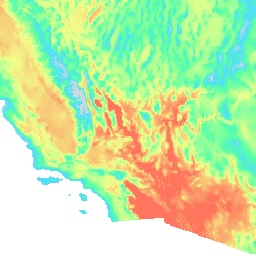Page Summary
-
The MACAv2-METDATA dataset contains monthly summaries from 20 global climate models covering the conterminous USA.
-
The dataset uses the MACA statistical downscaling method to improve the spatial patterns and remove historical biases of climate model output.
-
The dataset is available from 1900-01-01 to 2099-12-31 with a monthly cadence.
-
The dataset includes bands for various meteorological parameters such as temperature, humidity, precipitation, radiation, and wind speed.
-
The dataset is provided by the University of California Merced and is in the public domain under a Creative Commons CC0 1.0 Universal dedication.

- Dataset Availability
- 1900-01-01T00:00:00Z–2099-12-31T00:00:00Z
- Dataset Provider
- University of California Merced
- Cadence
- 1 Month
- Tags
Description
The MACAv2-METDATA dataset is a collection of 20 global climate models covering the conterminous USA. The Multivariate Adaptive Constructed Analogs (MACA) method is a statistical downscaling method which utilizes a training dataset (i.e. a meteorological observation dataset) to remove historical biases and match spatial patterns in climate model output.
The MACA method was used to downscale the model output from 20 global climate models (GCMs) of the Coupled Model Inter-Comparison Project 5 (CMIP5) for the historical GCM forcings (1950-2005) and the future Representative Concentration Pathways (RCPs) RCP 4.5 and RCP 8.5 scenarios (2006-2100) from the native resolution of the GCMS to 4km.
This version contains monthly summaries.
The full list of models can be found at: https://climate.northwestknowledge.net/MACA/GCMs.php
Bands
Pixel Size
4638.3 meters
Bands
| Name | Units | Min | Max | Pixel Size | Description |
|---|---|---|---|---|---|
tasmax |
K | 251.95* | 330.64* | meters | Monthly average of maximum daily temperature near surface |
tasmin |
K | 239.47* | 316.2* | meters | Monthly average of minimum daily temperature near surface |
huss |
Mass fraction | 0* | 0.03* | meters | Monthly average of mean daily specific humidity near surface |
pr |
mm | 0* | 3691.91* | meters | Total monthly precipitation amount at surface |
rsds |
W/m^2 | 15.84* | 419* | meters | Monthly average of mean daily downward shortwave radiation at surface |
was |
m/s | 0.23* | 14.16* | meters | Monthly average of mean daily near surface wind speed |
Image Properties
Image Properties
| Name | Type | Description |
|---|---|---|
| scenario | STRING | Name of the CMIP5 scenario, one of 'rcp85', 'rcp45', or 'historical' |
| model | STRING | Name of the CMIP5 model, eg 'inmcm4' |
| ensemble | STRING | Either 'r1i1p1' or 'r6i1p1' |
| month | DOUBLE | The index of the month in the year, ie 1-12 |
Terms of Use
Terms of Use
The MACA datasets were created with funding from the US government and are in the public domain in the United States. For further clarity, unless otherwise noted, the MACA datasets are made available with a Creative Commons CC0 1.0 Universal dedication. In short, John Abatzoglou waives all rights to the work worldwide under copyright law, including all related and neighboring rights, to the extent allowed by law. You can copy, modify, distribute, and perform the work, even for commercial purposes, all without asking permission. John Abatzoglou makes no warranties about the work, and disclaims liability for all uses of the work, to the fullest extent permitted by applicable law. Users should properly cite the source used in the creation of any reports and publications resulting from the use of this dataset and note the date when the data was acquired. For more information refer to the MACA References and License page.
Citations
Abatzoglou J.T. and Brown T.J., A comparison of statistical downscaling methods suited for wildfire applications, International Journal of Climatology(2012) doi:10.1002/joc.2312.
Explore with Earth Engine
Code Editor (JavaScript)
var dataset = ee.ImageCollection('IDAHO_EPSCOR/MACAv2_METDATA_MONTHLY') .filter(ee.Filter.date('2018-07-01', '2018-08-01')); var maximumTemperature = dataset.select('tasmax'); var maximumTemperatureVis = { min: 290.0, max: 314.0, palette: ['d8d8d8', '4addff', '5affa3', 'f2ff89', 'ff725c'], }; Map.setCenter(-115.356, 38.686, 5); Map.addLayer(maximumTemperature, maximumTemperatureVis, 'Maximum Temperature');